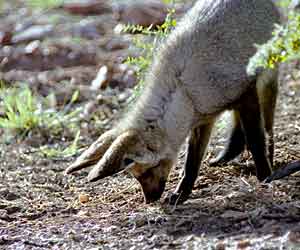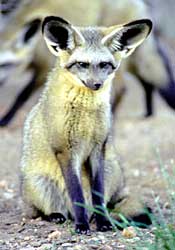


Classification
Order: Carnivora
Family: Canidae
Genus: Otocygon
Species: Megalotis
The bat-eared for is possibly named after the Egyptian slit-faced fruit bat, that also has ears which are large in proportion to its head. They are also known as Delalande’s fox.
These small foxes are dynamic animals, capable of successfully inhabiting a harsh environment. They are found almost throughout the whole of west and central South Africa and also occur in eastern Africa.
They make their homes in semi-arid regions such as the Kalahari and the Namib in areas with short grass and low scrub. In the summer month they are seldom seen during the day, but during the winter they may seen sunning themselves in the riverbeds. Riverbeds are usually their favourite habitat because there is plenty of their prey. However, when the conditions are less favourable they will roam to other places.
Appearance
The bat-eared foxes reach a length up to 820mm, including their bushy, dark-coloured tail. Their shoulder height when fully grown can reach 300mm and they have a maximum weight of 4 kg.
The sharp elongated muzzle and large ears (130mm long and 100mm wide) are well designed foraging tools that help to sustain the bat-eared foxes throughout its expected 12 year lifespan. They have a smoky grey-brown pelage consisting of three types of hair. The underfur is a mat of short, fine-fluffy hair that is overlaid by a coat of guard hairs. Through the coat of guard hairs there are a number of slightly longer tactile hairs that have a sensory function. The hairs of the tail and the slim legs are dark. Once a year the bat-eared fox will renew its coat by moulting.
Social structure and behaviour
The bat-eared fox is a relatively social animal, which is often found in groups of 2 to 4 adults. The males and females form a strong pair bond that may well be a lifelong commitment. Larger groups are seen when the cubs are old enough to be let out of the den to play and forage with the adults. The strength of the group bond is dependent on the availability of food, with larger groups forming when there are high concentrations of prey following good rains. Normally, bat eared foxes do not actively maintain territories but will have large home ranges.
There are no fixed marking patterns, they will defecate throughout their range. In the winter month urine-marking is increasing, but this is thought to be more closely related to the pair forming process, and is not thought to be a way of marking resource sites or ranges. Their home range do not compete directly with that of other predators but from time to time other predators do prey on the bat-eared fox.
Reproduction and parental care
The males and females will begin to strengthen their pair bond in July. A den site that they may have been used previously will be selected and modified to make it suitable for their offspring. These den sites are occasionally dug by the parents, but are usually burrows that have been excavated by other animals such as springhare or aardvark. Sometime between October and late January, after a gestation period of approximately 60 days, the female will give birth to 2 to 6 pups in the safety of the underground den. The size of the litter and the number of pups that survive depends on the availability of food, and thus the amount of rainfall.
The pups are dependant on their parents for everything. The mother will spend the majority of her time foraging for food to convert it into milk for her rapidly growing pups. She will return every 9 to 10 hours to suckle the pups. The father is the protector of the pups who will remain at or near the den site to ward off possible danger that could come from a variety of sources including the black-backed jackal, brown hyena and honey badger.
Raising a large litter is by no means an easy task. Therefore the parents have devised a plan to make life just a little bit easier for themselves. Another adult female, often a daughter from the last litter, will remain with the parents to assist them. She suckles the pups and brings food to the den for the male, so that he can stay close to the den to protect the pups.
As the pups grow, the demand for milk can no longer be provided. This causes the young bat-eared foxes to begin eating solid food. The mother and her assistant will bring prey such as geckos to the den site for the pups. As the pups become more adventurous, they will learn what can and cannot be eaten by exploring the vicinity around the den.
The pups gradually spend more and more time outside the den and the father’s job of protecting them becomes more challenging. When a predator locates the den, the bat-eared foxes will move off to a new den site as soon as possible. If a cub is too weak to move with the rest of the family, it will be left behind, often resulting in death, but ensuring, that only the fit survive. The mortality rate amongst pups is high and the whole litter seldom survives. Many of the deaths are due to starvation and predators, which dig up the dens when the father has to leave his guard post to feed.
By playing and copying their parents, the pups learn many valuable skills. Diving and turning at a moment’s notice will one day play a great role in their survival. Bonding is important for these social foxes and much time is spent grooming each other to remove unwanted parasites. If the number of parasites in the den becomes too high, they will move to a fresh site.
The mature pups may stay with the parents for a few months but will eventually move off to find their own mate and set up their own dens. The females can breed for the first time at approximately 18 month of age.
Feeding behaviour
In a harsh environment, the secret to survival is the ability to adapt the often difficult conditions. In summer, the hot days are no time to be out and about. Therefore, the bat-eared foxes will do most of their foraging by night. The winter nights in turn are far too cold for the bat-eared foxes and their prey, causing them to forage during the daylight hours.
Insects and other invertebrates make up the primary components of the bat-eared foxes’ diet, but they will also take small snakes, other reptiles and rodents. Wild berries and fruit also play an important role in the diet of bat-eared foxes. Harvester termites, Hodotermes mossambicus form the main base of insects consumed during the summer months. In winter the bat-eared foxes depend on a variety of ant species for food.
Locating insects, especially on dark summer nights, is quite a task. To do so, bat-eared foxes have developed an exceptional sense of hearing that allows them to use their large dish-shaped ears. They act as parabolic reflectors that amplify the sounds made by prey moving about under the soil surface. The bat-eared foxes will listen closely, and then with their front paws they quickly excavate the area from which the sound is emanating. The exposed prey is then snatched up in the sharply pointed jaws and finally eaten. When breeding, a mother and her assistant will take food back to the den for the pups and for the father.
Predator relationships
The male is the defender of the dens and will try to chase away any intruder that would possibly threaten his pups. This includes the black-backed jackal, slender mongoose and brown hyena. The male will confront the intruder and attempt to escort him away from the pups with his tail held high as sign of aggression. They will also “stot”. This is when a bat-eared fox will straighten and lock its limbs, leaping or bouncing into the air. This is not known to occur in other canids. If there are a number of mature bat-eared foxes, they may also mob the intruder to distract it, or even run in front of a predator, chasing each other to confuse and distract the hunter.
Communication and territory marking
The type of environment, in which the bat-eared fox lives, will greatly influence the type of communication that takes place. Much of the communication between them has developed from a variety of graded body postures used in different combinations and contexts. These postures have evolved through play and rituals such as greeting.
The bat-eared fox also makes great use of facial expressions and tail posture to communicate, as well as some olfactory signals. Calling or vocal communication has been noted to increase during the winter months, possibly because of the increase in sexual activity and pairing which takes place at this time of the year. Vocal communication is also used to call others to an abundant source of food.